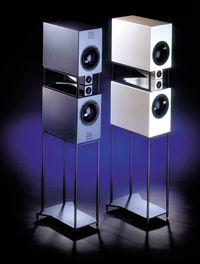| Columns Retired Columns & Blogs |
Morel Octwin 5.2M loudspeaker
I first became familiar with Israeli speaker manufacturer Morel, founded in 1975, back in the late 1970s, when they had a drive-unit plant in the UK. Their drivers have always been well-respected—I was mightily impressed with a sample of their T33 1" soft-dome tweeter when I had the opportunity to measure it a decade or so ago—so when I heard their Octwin 5.2 dual-speaker system at the 2002 CEDIA conference, I asked for a pair for review.
 The first samples to take up residence in Stereophile's storeroom used Corian enclosures. For various reasons, I never quite got to the point where I was ready to take them home. Then, at Home Entertainment 2003, Morel asked if they could replace those samples with new ones that used more conventional MDF enclosures and were significantly less expensive: $4400/system compared with $8000/system. "Yes" is all I said.
The first samples to take up residence in Stereophile's storeroom used Corian enclosures. For various reasons, I never quite got to the point where I was ready to take them home. Then, at Home Entertainment 2003, Morel asked if they could replace those samples with new ones that used more conventional MDF enclosures and were significantly less expensive: $4400/system compared with $8000/system. "Yes" is all I said.
The Octave Twin
Morel's Octave 5.2 loudspeaker is one of Morel's MusicDeco series. A small, elegantly finished two-way, it features a reflex-loaded plastic-cone woofer just over 5" in diameter, with a large dustcap indicating the presence of its oversize, 3" voice-coil. The tweeter is a 1.1" silk-dome unit that uses a tiny neodymium magnet to allow it be housed in a pod on top of the cabinet proper. The woofer uses a hybrid ferrite-neodymium magnet, and the voice-coils of both units are wound with hexagonal cross-section wire to get the most conductor into the magnet gap. Aluminum wire is used to lower the moving mass.
The inner surfaces of the MDF cabinet are coated with a layer of bituminous damping, the outer surfaces in a 3/16"-thick polymer polished to a "piano" finish. The bass alignment is achieved with two small, triangular ports on the cabinet's rear, formed from the internal bracing. The first-order crossover—set lower than usual, at 1.4kHz—uses high-quality components and van den Hul silver wiring, and electrical connection is via a single inset pair of binding posts. There are no grilles; to minimize acoustic interference, the speakers are supplied with minimal metal-frame ST-51 stands.
To make an Octwin 5.2M system, a second set of Octave 5.2 speakers is inverted and placed atop the first, with the tweeter modules almost touching. A small, metal-frame, intermediate stand (the ST-11) ensures that the modules don't actually touch, and provides a stable base for the upper speaker of the pair. Electrical connection to the lower speaker of each twinned pair is via its usual binding posts; drive to the upper speaker is via a small module at the rear of the ST-11 stand, which rolls off its tweeter to minimize vertical interference effects in the treble.
Sonics
I initially set the Morels up where the Earthworks Sigma 6.2 and Monitor Audio Silver S2 speakers (which I reviewed in June and August, respectively) had worked well: relatively far out into the room. However, I ended up moving the 5.2Ms back about 15" from those positions to bring up the bass region to a musically satisfying level. The speakers were now 5' from the wall behind them and 3.5' from the sidewalls.
The Octwin 5.2Ms sat on their dedicated stands, which placed the axis between the two tweeters a little below my ear height—this is what Morel recommends for the best imaging. Dual-mono pink noise (from Editor's Choice, Stereophile STPH016-2) sounded rather hollow if I started to stand or slumped in my chair, but was smooth on-axis. Imaging was stable and accurate, a narrow, centrally positioned image of the noise appearing in the treble and lower midrange. However, the central image did splash to the sides in a narrow band of midrange frequencies.
- Log in or register to post comments




































